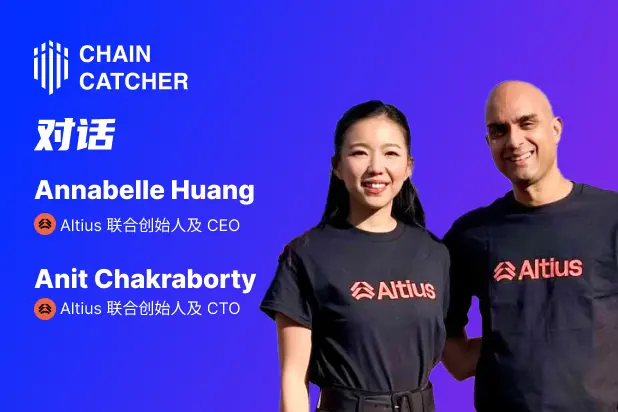Celestia on-chain data analysis: Only 0.1% of data capacity is being used, and it could generate $5 million in annual fee revenue when fully loaded
Written by: Dan Smith
Compiled by: Deep Tide TechFlow
In today's crypto world, modular blockchains have become a major narrative. Crypto researcher Dan Smith has delved into the data situation of the modular blockchain Celestia and has written in detail about Celestia's fees, user demands, and charging models, with Deep Tide compiling the full text.
Summary
Currently, user demand is low, but this is not a problem. The team has successfully implemented RaaS integration.
Fees may be a long-term issue; where will sustainable demand come from?
First-price auctions are inefficient, as demonstrated by Manta.
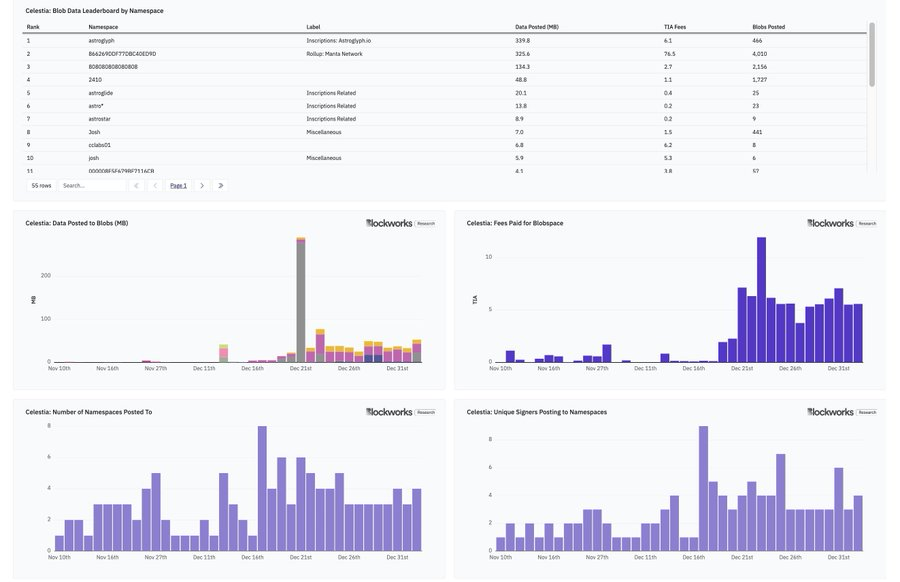
Background
Celestia is designed specifically for data availability networks. Compared to the current largest DA layer, the Ethereum mainnet, it can reduce data costs by 99.9%.
Users can publish any data into a "blob" in a designated "namespace." The blob contains data and other key information, including the namespace as the blob ID.
Then, users can access the data by querying Celestia's "blobspace" and filtering for specific namespaces.
Namespaces can be hexadecimal encoded, base64 encoded, or plain text strings.
Application developers are encouraged to use plain text strings so we won't have to guess which namespace your Rollup is published to!
Current On-Chain Activity
Celestia was launched just two months ago. So far, users have published data to a total of 56 namespaces. We typically see users publishing 30-50 MB of data to 3-6 namespaces daily.
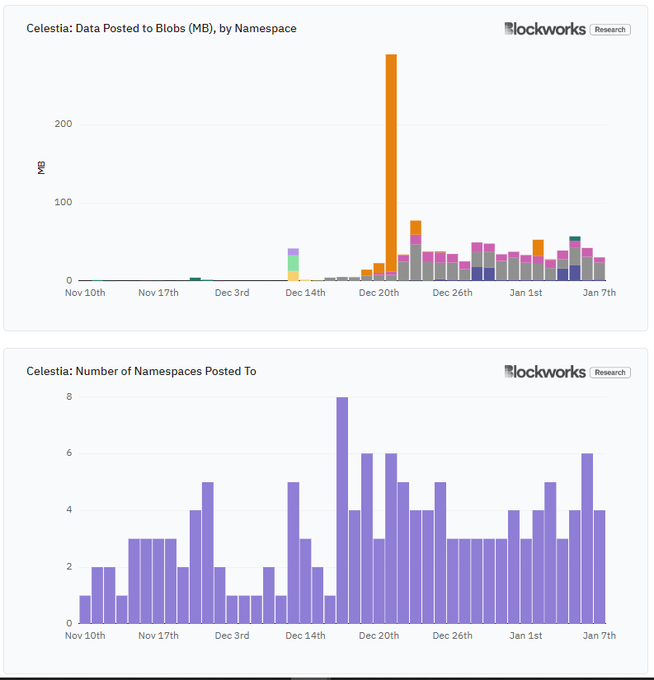
Of all the data published to Celestia, 87% has been sent to 3 namespaces:
Astroglyph, an inscription service that allows users to publish any data on Celestia.
MantaNetwork, which launched the OP Stack Rollup alongside Caldera.
808080808080808, an unknown namespace that appears to be a Rollup.
In contrast, the Ethereum mainnet currently has about 15 Rollups, publishing 700 MB of data daily, with Arbitrum and OP Mainnet publishing approximately 120 MB and 80 MB of data daily, respectively.
After the launch of EIP-4844, Ethereum will support a maximum of 5400 MB of data daily.
Ethereum prioritizes scarce block space, while Celestia is built on abundant block space.
With a 15-second block time and 8 MB blocks, the network currently supports up to 46,080 MB of data daily. In other words, only 0.1% of Celestia's data capacity is currently being used.
A 0.1% utilization rate, considering Celestia's only two-month history. I wouldn't take this as a signal of insufficient demand.
Fees
Currently, the data utilization rate is 0.1%, and total fees are notably low. Celestia generates about 5 TIA or $65 in fees daily.
This means Celestia users pay 0.024 - 0.24 TIA or $0.31 to $3.12 for each MB of data published.
Current fees are low, but what about the future? If Celestia achieves an annual data capacity of 46,080 MB at a TIA price of $13, the network would generate about $5.2 million in annual fees. This would be 65 times the current data published to Ethereum.
If growth continues, users will be forced into bidding wars, and fees will increase as users' price tolerance rises.
The network can vote to increase the block size from 8 MB to larger sizes, but the number of light nodes and the limitations of the Cosmos SDK restrict the maximum block size.
User Demand
So, where will the 65 times demand come from? Is it from high TPS general chains, specific applications, or games?
It's hard to say, but even so, these fees are negligible compared to current valuations.
However, you cannot pinpoint the source of demand today, nor can you clearly state that this is the reason for Celestia's future growth, but that doesn't mean it won't happen.
My guess is that games + high TPS Rollups will achieve this. EIP-4844 doesn't seem to allow L2s to achieve transactions below a cent, but Celestia does.
I think it's clear that in the coming months, we will see a surge of chains utilizing Celestia's RaaS coming to market.
The Celestia team has done an excellent job in integration and marketing. Anyone building a Rollup knows about Celestia and has the option to use it.
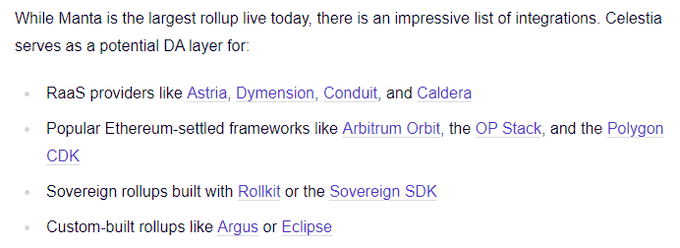
But from early observations, most Rollups built with RaaS won't provide much long-term service for users.
So where will the sustainable demand for DA come from?
Charging Model
You may also have noticed the disparity in fees paid by users for publishing data, which is entirely driven by Manta Network, which pays 10 times more than others!
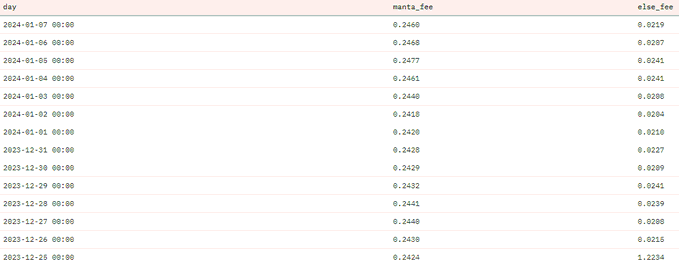
Celestia uses a simple first-price auction fee mechanism, similar to Ethereum before EIP-1559. This design does not provide users with a straightforward way to bid a fair price, leading to bidding wars and users overpaying for block space.
(Deep Tide Note: "First-price auctions" are a format in which the highest bidder wins the item and pays their highest bid. This contrasts with the more common "second-price auction" (like those used by eBay), where the highest bidder wins the item but only pays the second-highest bid.)
In first-price auctions, bidders need to be more cautious when bidding, as they must balance the need to bid high enough to win the auction with the need to avoid overpaying. This type of auction typically requires bidders to guess the bids of other potential bidders, increasing the complexity of the strategy.
Since Celestia is built specifically for DA, there are no competing transaction types or high-value DeFi transactions that would increase the Gas costs for publishing DA, alleviating most concerns about the fee model.
Once the existing data capacity reaches its maximum, more robust mechanisms can be prioritized.
In summary, I am excited about what Celestia is doing. They have a strong team, a powerful vision, and a robust product. I am not worried about the current low fees, but I think they need to emphasize this repeatedly in the future. Integrating other products may make more sense.







